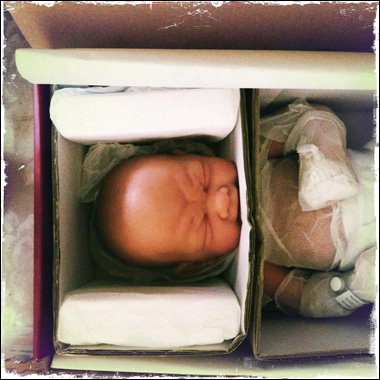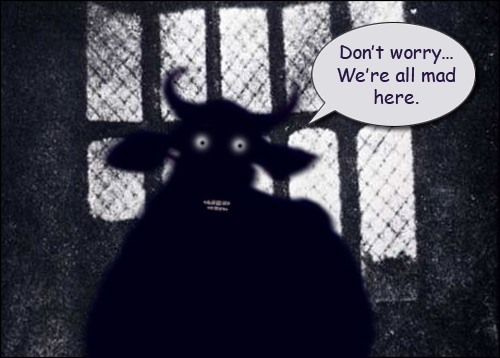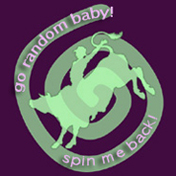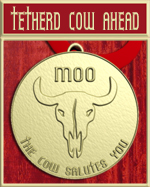You know, I reckon that if Jesus could have looked forward in time to all the things for which he’d be responsible, he’d have stayed in the carpentry workshop and carved out a career making sideboards and nice nested table sets.
Entries tagged with “Creepy”.
Tue 27 Dec 2011
Thunderbirds are Go
Posted by anaglyph under Creepy, Idiots, Insane People, Laughs, Religion, Skeptical Thinking, Stupidity
[12] Comments
Tue 15 Nov 2011
Troll’s Butter
Posted by anaglyph under Australiana, Bizarre, Creepy, Ooky, Science
[23] Comments

You may remember that some time back I told you about the exceedingly odd Bleeding Tooth Fungus that grew in my backyard. Well now, after Violet Towne spotted the above seaweed-like stuff on our driveway the other day, I think I may have to start up a new Cow Category called ‘Weird Shit That Mysteriously Appears In My Garden’. There were dozens of clumps of it, and it looks just like something you might find on the beach at low tide. ((Or in a troll’s nostril.)) Only we’re 20 kilometers away from the nearest ocean, and this stuff was still damp.
Turns out that this is the colony form of a rehydrated genus of cyanobacteria called Nostoc. Nostoc can be found pretty much everywhere in the world, and due to the bacteria’s ability to survive (and even thrive) in harsh environments it is even quite happy in the Arctic and Antarctic.
Most of the time the Nostoc colony goes completely unnoticed, but after a lot of rain, it may swell up into jelly-like blobs such as the ones in my garden. Its sudden appearance on the ground with no apparent cause has earned it the folk name of Star Jelly, as it was thought to have fallen from the sky.
Nostoc is also known (much more evocatively) as Witches’ Butter or Troll’s Butter and some species are in fact eaten, particularly in Asia where people seem to delight in gobbling down disgusting things. There’s no way I’m chowing down on it. For one thing it’s been found to containe Beta-methylamino L-alanine, a toxic amino acid that has been implicated in degenerative brain diseases. ((Although I have to say that in my opinion anyone who would consider eating it is well along the degenerative brain disease path in the first place…))
I have a simple dietary guideline in this respect: Never eat or drink anything that looks or smells like some kind of biological excretion. It has served me well thus far.
Wed 2 Nov 2011
Evil Watermelon Child
Posted by anaglyph under Australiana, Creepy, Daft Advertising, Food & Drink
[12] Comments

ALDI: fire your advertising agency. They’re creeping me out.
Wed 28 Sep 2011
Would You Like That Gift-wrapped?
Posted by anaglyph under Australiana, Bizarre, Creepy, Ephemera, Ooky, Scary
[12] Comments

Sometimes you find some very disconcerting things whilst browsing in secondhand shops.
Tue 30 Aug 2011
Clever Butt?
Posted by anaglyph under Bizarre, Creepy, In The News, Religion, Robots, Science, Technology
[15] Comments
Researchers at the Cornell Creative Machine Lab came up with the brilliant idea of getting Cleverbot, their ‘intelligent’ chat program, to engage with its own doppelganger.
Clever Clogs: meet Clever Clogs.
Awesome.
Thu 24 Mar 2011
Last Night I Saw Upon the Stair…
Posted by anaglyph under Bizarre, Creepy, Medicine, Science
[26] Comments

Charles Bonnet Syndrome is an unusual neurological affliction that causes mentally healthy people to see things that aren’t actually there. It is usually associated with advancing age and is thought to affect between 10% – 40% of people. Hallucinations seen by those with Bonnet’s Syndrome range from colourful patterns and textures on walls, through out-of-place objects such as bottles and vases of flowers, to animals and faces and people. Perhaps one of the strangest things about the affliction is that the hallucinated items often appear to interact with the sufferer’s real environment. Charles Bonnet, who first described the disorder, observed it in his 89 year old grandfather who hallucinated birds, horse-drawn carriages, animals and perhaps most disturbingly of all, a man who would come into his bedroom and smoke a pipe in the evenings, and who was still there the next morning when the old man awoke…
The British Medical Journal reports the case of an 87 year old widower who had, for six weeks previous to his diagnosis with the condition, been seeing people and animals in his house, including bears and Highland cattle.
He knew that these visions were not real and they didn’t bother him much, but he thought he might be losing his mind. The visions lasted for minutes to hours, and the cattle used to stare at him while quietly munching away at the grass.
Bonnet’s Syndrome occurs mostly in people with some kind of macular degeneration, and the most likely explanation for what is going on is that the sufferer’s brain, lacking the visual information it is accustomed to receiving, feels obliged to conjure up something to fill the space. That it chooses to integrate that ‘something’ with the world of the patient is perhaps the weirdest part of the illness.
The lesson here, in case this post seems somewhat obtuse, is that you quite literally can’t always believe your eyes. The strangeness of Charles Bonnet Syndrome illustrates profoundly how deeply etched into our being is the ‘need’ to make sense of the world in some way when deprived of the proper data. In the case of the sufferer of Bonnet’s Syndrome, the brain makes an unmistakeable and totally misleading judgment call.
If you’d like to read more about Charles Bonnet Syndrome there’s a great piece on Damn Interesting.
___________________________________________________________________________
Image (in part) by William Fox Talbot from Wikimedia Commons
___________________________________________________________________________



